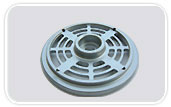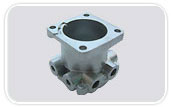Infrastructure Diecasting Machines
We have 6 pressure die casting machines installed in our factory having capabilities upto 120T in cold , chamber process and upto 40T in hotchamber process .
Machine Room
1. Pressdure Die Casting Machines:
| PTC 80 Ton | 2 No.s |
| RF 80 Ton | 1 No.s |
| SS 80 Ton | 1 No.s |
| TC 80 Ton | 1 No.s |
| Verticial Die Casting Machine | 1 No.s |
COMPRESSORS & OTHER MISCELLANEOUS ITEMS, INCLUDING STATE OF THE ART
EXHAUST SYSTEM.
2. Trimming Press 20 Ton : 1 Nos
3. Fired Furnaces Reilo-G-10 : 10 Nos
4. Lathe Machine : 6 Nos
5. Generators :
- A : Currmins 125 KVA : 2 Nos
- B : Currmins 75 KVA : 1 Nos
6. Cooling Tower Fabricated : 1 Nos
7. Scale Preventive System : 1 Nos
8. Drill Machine Itco. : 1 Nos
9. Tapping attachment Local : 7 Nos
10. Tapping Machine Local : 2 Nos
11. Complete Air Cooling system : 1 Nos
12. Grinding Machine : 1 Nos
13. Weighing Scale-AMAN 1 Ton : 2 Nos
14. Hand Grinder (Black & Decker) : 2 Nos
15. Compressor Local 150 : 1 Nos
16. Air Pollution Control Equipment : 2 Nos
17. Centralised Cooling System : 1 Nos
Die Casting
The process involves injection of molten metal into a die steel mould
under high pressure (1,450-30,500psi) and is allowed to solidify in the
cavity inside the mould, and then removed producing a fabricated part.
This results in a more uniform part, generally good surface finish and
good dimensional accuracy. Pressure die casting is a process where metal is melted and forced into
steel dies. The metal hardens into the desired shape. Mol
metal is injected into a die cavity through a channel by movement of
a plunger. After a preset solidification time, the plunger reverses
direction, the part is ejected, and the machine is ready for the next
cycle.
Pressure die casting is a process where metal is melted and forced into
steel dies. The metal hardens into the desired shape. Mol
metal is injected into a die cavity through a channel by movement of
a plunger. After a preset solidification time, the plunger reverses
direction, the part is ejected, and the machine is ready for the next
cycle.
In hot chamber casting a plunger traps a certain volume of
molten metal and forces it into the die cavity through a gooseneck and
nozzle. Metals having low melting points such as zinc, copper, magnesium
and lead are cast using hot chamber die casting. In cold chamber
casting molten metal is poured into the injection cylinder. The metal is
forced into the die cavity at high pressures. High melting point alloys
of aluminum and copper are normally cast using cold chamber die
casting.
Highly Skilled & Experienced Staff
Tool designers, tool & die makers who have the expertise and experience
of designing and fabricating highly comrJlicated and intricate die casting
dies within close tolerances to the highest level of accuracy and perfection.

Tool Room
| Lathe Machine | 2 No.s |
| Drill Machine | 7.No.s |
| Milling Machine | 1 No.s |
| Grinding Machine | 2 No.s |
| Weighing Machine AMAN(1 ton) | 2 No.s |
Finishing
The most important step in the entire finishing process is the surface
preparation of metals and the cleaning process. This is because the appearance
and acceptance of the article depend primarily on a sound finish achieved
with a clean and active substrate. The desired surface finish is achieved
through the following methods:
1. Deburring & Descaling
This is done by filing, tumbling and blasting with sand, grit or vapor. This is then followed by pickling process where the component is immersed in acid to remove rust, scale, workshop soil &oil, grease, tarnish, light oxides, dirt and any other material. These should be removed to ensure strong adherence of electrodeposited metal to the piece.
2. Polishing -
It is done after the surface has been subjected to grinding or wire brushing. This method alters the surface of the metal through the use of a variety of abrasives: coarse, medium, fine and so on. This operation smoothens the surface of the metal.
3. Buffing
It further smoothens the metal surface and improves its appearance by the application of very fine abrasives to produce different types of finishes (e. g., satin, brushed, mirror finish, etc.)
4. Electrolytic Cleaning
this process is performed on the metal surface prior to electroplating. It is more efficient than soak cleaning and considerably minimizes chemical attack on the metal surface.
5. Ultrasonic cleaning
the use of high-frequency waves called ultrasonic waves enhance cleaning efficiency of components with cavities and intricate shapes.
6. Electroplating
Electroplating is a process of coating an object, usually metallic, with one or more relatively thin layer of some other metal like copper, chrome, nickel, etc. by means of electrochemical process. The electroplating process is essentially preceeded by the ultrasonic cleaning process to achieve high quality of surface finish.
7. Electrophoretic Lacquering
 -
- The process relies on the migration and deposition of charged particles from a solution (lacquer) onto an opposite-polarity substrate (work piece) under the application of an external power supply. Lacquer coating may be applied by any route from a simple dipping to the more sophisticated electrophoretic method. Some installations replace electroplating completely by using lacquering direct onto base metals to produce replacements for electroplating.
8. Powder Coating
- Powder coating is the technique of applying dry paint to a part. The finish is the same as a 2-pack wet paint. In powder coating, the powdered paint is electrostatically charged and sprayed onto the part. The part is then placed in an oven and the powder particles melt and coalesce to form a continuous film.
9. Zinc Plating
Zinc plating prevents oxidation of the protected metal by forming a barrier and by acting as a sacrificial anode if this barrier is damaged. Zinc oxide is a fine white dust that (in contrast to iron oxide) does not cause a breakdown of the substrate's surface integrity as it is formed.
10. Hot Dip Galvanizing -
It is the process of coating iron or steel with a zinc layer, by passing the steel through a molten bath of zinc at a temperature of around 460 °C. When exposed to the atmosphere, pure zinc reacts with oxygen to form zinc oxide, which further reacts with carbon dioxide to form zinc carbonate, a dull grey, fairly strong material that stops further corrosion in many circumstances, protecting the steel below from the elements. Galvanized steel is widely used in applications where rust resistance is needed and can be processed in much the same way as uncoated.
Our finishing section is equipped with following machines:
Inspection And Testing
Finished Products are thoroughly tested before they're packed.
| 1 | Digital Vernier 6" | Mitutoyo | 2 No.s |
| 2 | Plane Vernier | -do- | 2 No.s |
| 3 | Dial Vernier | -do- | 6.No.s |
| 4 | Dial Gauge | Baker | 5 No.s |
| 5 | Micrometer | Mitutoyo | 3 No.s |
| 6 | Filler Gauge | Globe | 3 No.s |
| 7 | Angle Protector | Tower | 2 No.s |
| 8 | Temperature Indicator | Auditronics | 1 No.s |
| 9 | Deformation Gauge | Local | 1 No.s |
| 10 | Pressure Gauge | Skon | 2 No.s |
| 11 | Surface Plate | - | 3 No.s |
ADDITIONAL CAPABILITIES
We also offer Products in the following category: CNC Turning Pressing / stamping components / Brass casted / forged components





